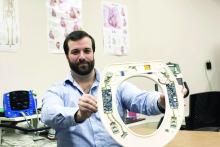User login
It’s the pits
Physical therapists sometimes use therapeutic ball pits to provide stimulation to pediatric patients with sensory impairments. However, anyone who’s ever been to a fast food joint or a Chuck E. Cheeses in the last 30 years knows that ball pits are not as innocent as they seem – instead of being simply a joyous sunken hole of fun, they are a prime breeding ground for all sorts of bacteria. And adhesive bandages. Why are there always bandages??
Researchers recently took a deep, disgusting dive into the underworld of clinical ball pits, which do not seem to be regulated by any governing body. There are no clinical guidelines from the Ball Pit Association of America on how or when to clean these cesspools of spheres. In fact, there’s no Ball Pit Association of America at all! Shocking.
Unsurprisingly (for any parent or person older than 14), the ball pits sampled were teeming with human and zoonotic-associated microorganisms. Researchers found that “bacterial colonization was found to be as high as thousands of cells per ball” (gag), exposing children to a lot of opportunity for infections. In case the diapers and bandages swimming in the McDonald’s ball pit didn’t turn you off them, this certainly should.
Zom-bacteria are coming
Special edition: Zombie Bacteria vs. The World. Recent research reveals that one type of bacteria, Bacillus subtilis, enters an oligotrophic state when nutrient starved, in which they are not fully dormant but verrrrrry slowly continue to grow and divide. Much like zombies verrrrry slowly continue to walk and eat flesh.
This research fundamentally changes the way we look at bacteria’s ability to survive. Previously, all bacteria were thought to go into a state of complete dormancy within a protective endospore. It appears that the zombie-like bacteria can awaken more easily from their oligotrophic state than bacteria using an endospore, which may shed light on how bacteria can escape antibiotic treatments. As if superbugs weren’t enough to deal with already.
An OTC beer keeps the doctor away
There’s plenty of evidence that a beer or two every now and again is good for your health. But the owner of the Seery Athlone Brewing Company in Addison, Ill., may have taken things too far.
While the reason of its closure just a few months after its grand opening in December 2018 is technically still a mystery, we feel fairly safe in speculating that it had something to do with the fact that brewery owner James Stephen was making his beer at the same location as his main business – a pharmaceutical company engaging in testing of over-the-counter drugs.
In fact, the Food and Drug Administration sent Mr. Stephen a letter in August 2018 warning him that, among numerous other transgressions, fermenting beer literally 10 feet away from where drugs were being tested is a health hazard, for both the beer and the drugs. The FDA ordered the brewery shut down, but the intrepid Mr. Stephen soldiered on, to obviously limited success.
Our advice to Mr. Stephen? Go all in with the pharmaceutical theme. Who wouldn’t want to drink an ibuprofen IPA, ranitidine red ale, loratadine lambic, pseudoephedrine porter, or diphenhydramine doppelbock? You’ll make millions!
A seat in the oval office
No, not that seat, and not the Oval Office. This is LOTME, after all, not Politico. The “seat” we’re talking about is a cardiovascular monitoring system, and “oval office” is just a euphemism for a toilet.
Here’s the deal: A company called Heart Health Intelligence (See? Intelligence is involved, so clearly we’re not talking about politics) has developed a toilet seat equipped “with an integrated electrocardiogram, ballistocardiogram , and photoplethysmogram … capable of clinical-grade measurements of systolic and diastolic blood pressure, stroke volume, and peripheral blood oxygenation.” Wait, ballistocardiogram? That sounds like something from that show House; it sounds too cool to pass up: “Chase, you idiot, why didn’t you do that ballistocardiogram I ordered?”
The idea is to prevent expensive readmissions by keeping track of patients with heart failure after they leave the hospital in a way that fits into their daily routine and ensures adherence.
It would cost about $200,000 to provide 150 heart failure patients with the toilet seats when they left the hospital, the company estimated, but the penalties from the Centers for Medicare & Medicaid Services for readmitting 150 patients come to $500,000 a year. Thus saving money by flushing it down the toilet.
So it looks like we were talking about politics after all. An intelligent toilet seat is like the Oval Office because, in both cases, the buck stops here.

It’s the pits
Physical therapists sometimes use therapeutic ball pits to provide stimulation to pediatric patients with sensory impairments. However, anyone who’s ever been to a fast food joint or a Chuck E. Cheeses in the last 30 years knows that ball pits are not as innocent as they seem – instead of being simply a joyous sunken hole of fun, they are a prime breeding ground for all sorts of bacteria. And adhesive bandages. Why are there always bandages??
Researchers recently took a deep, disgusting dive into the underworld of clinical ball pits, which do not seem to be regulated by any governing body. There are no clinical guidelines from the Ball Pit Association of America on how or when to clean these cesspools of spheres. In fact, there’s no Ball Pit Association of America at all! Shocking.
Unsurprisingly (for any parent or person older than 14), the ball pits sampled were teeming with human and zoonotic-associated microorganisms. Researchers found that “bacterial colonization was found to be as high as thousands of cells per ball” (gag), exposing children to a lot of opportunity for infections. In case the diapers and bandages swimming in the McDonald’s ball pit didn’t turn you off them, this certainly should.
Zom-bacteria are coming
Special edition: Zombie Bacteria vs. The World. Recent research reveals that one type of bacteria, Bacillus subtilis, enters an oligotrophic state when nutrient starved, in which they are not fully dormant but verrrrrry slowly continue to grow and divide. Much like zombies verrrrry slowly continue to walk and eat flesh.
This research fundamentally changes the way we look at bacteria’s ability to survive. Previously, all bacteria were thought to go into a state of complete dormancy within a protective endospore. It appears that the zombie-like bacteria can awaken more easily from their oligotrophic state than bacteria using an endospore, which may shed light on how bacteria can escape antibiotic treatments. As if superbugs weren’t enough to deal with already.
An OTC beer keeps the doctor away
There’s plenty of evidence that a beer or two every now and again is good for your health. But the owner of the Seery Athlone Brewing Company in Addison, Ill., may have taken things too far.
While the reason of its closure just a few months after its grand opening in December 2018 is technically still a mystery, we feel fairly safe in speculating that it had something to do with the fact that brewery owner James Stephen was making his beer at the same location as his main business – a pharmaceutical company engaging in testing of over-the-counter drugs.
In fact, the Food and Drug Administration sent Mr. Stephen a letter in August 2018 warning him that, among numerous other transgressions, fermenting beer literally 10 feet away from where drugs were being tested is a health hazard, for both the beer and the drugs. The FDA ordered the brewery shut down, but the intrepid Mr. Stephen soldiered on, to obviously limited success.
Our advice to Mr. Stephen? Go all in with the pharmaceutical theme. Who wouldn’t want to drink an ibuprofen IPA, ranitidine red ale, loratadine lambic, pseudoephedrine porter, or diphenhydramine doppelbock? You’ll make millions!
A seat in the oval office
No, not that seat, and not the Oval Office. This is LOTME, after all, not Politico. The “seat” we’re talking about is a cardiovascular monitoring system, and “oval office” is just a euphemism for a toilet.
Here’s the deal: A company called Heart Health Intelligence (See? Intelligence is involved, so clearly we’re not talking about politics) has developed a toilet seat equipped “with an integrated electrocardiogram, ballistocardiogram , and photoplethysmogram … capable of clinical-grade measurements of systolic and diastolic blood pressure, stroke volume, and peripheral blood oxygenation.” Wait, ballistocardiogram? That sounds like something from that show House; it sounds too cool to pass up: “Chase, you idiot, why didn’t you do that ballistocardiogram I ordered?”
The idea is to prevent expensive readmissions by keeping track of patients with heart failure after they leave the hospital in a way that fits into their daily routine and ensures adherence.
It would cost about $200,000 to provide 150 heart failure patients with the toilet seats when they left the hospital, the company estimated, but the penalties from the Centers for Medicare & Medicaid Services for readmitting 150 patients come to $500,000 a year. Thus saving money by flushing it down the toilet.
So it looks like we were talking about politics after all. An intelligent toilet seat is like the Oval Office because, in both cases, the buck stops here.

It’s the pits
Physical therapists sometimes use therapeutic ball pits to provide stimulation to pediatric patients with sensory impairments. However, anyone who’s ever been to a fast food joint or a Chuck E. Cheeses in the last 30 years knows that ball pits are not as innocent as they seem – instead of being simply a joyous sunken hole of fun, they are a prime breeding ground for all sorts of bacteria. And adhesive bandages. Why are there always bandages??
Researchers recently took a deep, disgusting dive into the underworld of clinical ball pits, which do not seem to be regulated by any governing body. There are no clinical guidelines from the Ball Pit Association of America on how or when to clean these cesspools of spheres. In fact, there’s no Ball Pit Association of America at all! Shocking.
Unsurprisingly (for any parent or person older than 14), the ball pits sampled were teeming with human and zoonotic-associated microorganisms. Researchers found that “bacterial colonization was found to be as high as thousands of cells per ball” (gag), exposing children to a lot of opportunity for infections. In case the diapers and bandages swimming in the McDonald’s ball pit didn’t turn you off them, this certainly should.
Zom-bacteria are coming
Special edition: Zombie Bacteria vs. The World. Recent research reveals that one type of bacteria, Bacillus subtilis, enters an oligotrophic state when nutrient starved, in which they are not fully dormant but verrrrrry slowly continue to grow and divide. Much like zombies verrrrry slowly continue to walk and eat flesh.
This research fundamentally changes the way we look at bacteria’s ability to survive. Previously, all bacteria were thought to go into a state of complete dormancy within a protective endospore. It appears that the zombie-like bacteria can awaken more easily from their oligotrophic state than bacteria using an endospore, which may shed light on how bacteria can escape antibiotic treatments. As if superbugs weren’t enough to deal with already.
An OTC beer keeps the doctor away
There’s plenty of evidence that a beer or two every now and again is good for your health. But the owner of the Seery Athlone Brewing Company in Addison, Ill., may have taken things too far.
While the reason of its closure just a few months after its grand opening in December 2018 is technically still a mystery, we feel fairly safe in speculating that it had something to do with the fact that brewery owner James Stephen was making his beer at the same location as his main business – a pharmaceutical company engaging in testing of over-the-counter drugs.
In fact, the Food and Drug Administration sent Mr. Stephen a letter in August 2018 warning him that, among numerous other transgressions, fermenting beer literally 10 feet away from where drugs were being tested is a health hazard, for both the beer and the drugs. The FDA ordered the brewery shut down, but the intrepid Mr. Stephen soldiered on, to obviously limited success.
Our advice to Mr. Stephen? Go all in with the pharmaceutical theme. Who wouldn’t want to drink an ibuprofen IPA, ranitidine red ale, loratadine lambic, pseudoephedrine porter, or diphenhydramine doppelbock? You’ll make millions!
A seat in the oval office
No, not that seat, and not the Oval Office. This is LOTME, after all, not Politico. The “seat” we’re talking about is a cardiovascular monitoring system, and “oval office” is just a euphemism for a toilet.
Here’s the deal: A company called Heart Health Intelligence (See? Intelligence is involved, so clearly we’re not talking about politics) has developed a toilet seat equipped “with an integrated electrocardiogram, ballistocardiogram , and photoplethysmogram … capable of clinical-grade measurements of systolic and diastolic blood pressure, stroke volume, and peripheral blood oxygenation.” Wait, ballistocardiogram? That sounds like something from that show House; it sounds too cool to pass up: “Chase, you idiot, why didn’t you do that ballistocardiogram I ordered?”
The idea is to prevent expensive readmissions by keeping track of patients with heart failure after they leave the hospital in a way that fits into their daily routine and ensures adherence.
It would cost about $200,000 to provide 150 heart failure patients with the toilet seats when they left the hospital, the company estimated, but the penalties from the Centers for Medicare & Medicaid Services for readmitting 150 patients come to $500,000 a year. Thus saving money by flushing it down the toilet.
So it looks like we were talking about politics after all. An intelligent toilet seat is like the Oval Office because, in both cases, the buck stops here.





